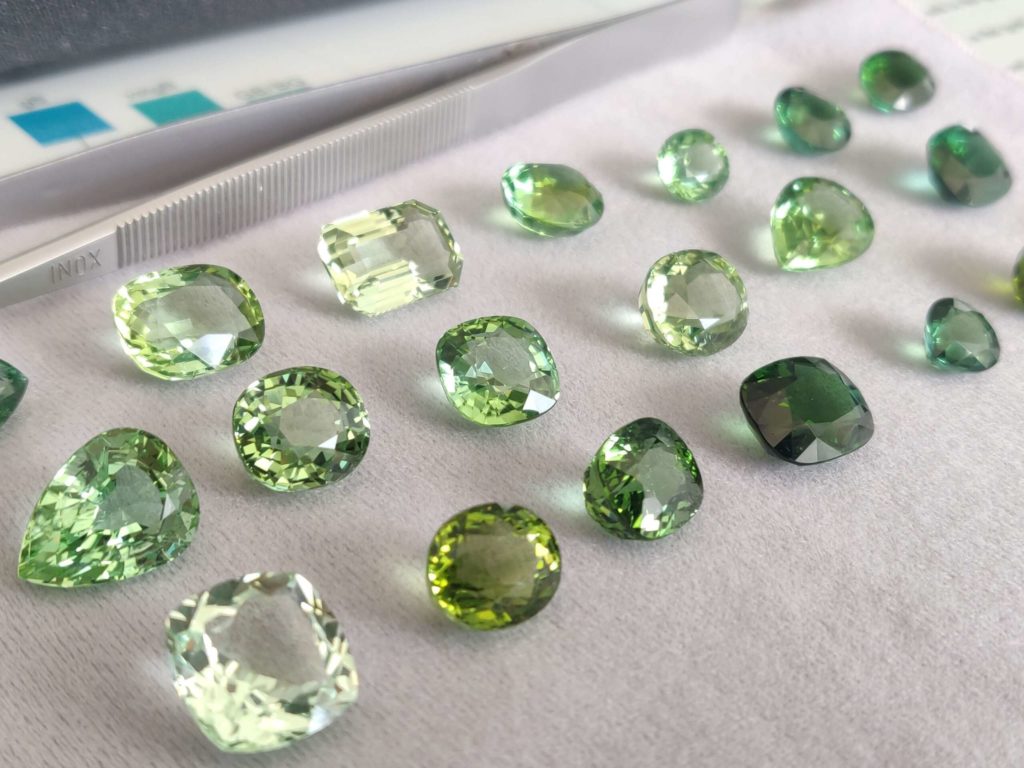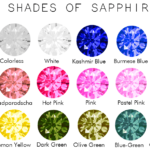Mint Tourmaline: Freshness That Makes Cents January 2021!
Call it the charm of simplicity or the allure of something earthy, mint tourmalines make for a fresh detour from conventionally popular saturated hues. While the term “mint” has been in usage in the English language since 1766, it was only in 1920 that it was used to describe a color that sits snugly halfway between cyan and green. While mint green found immense favor during the art deco era, being paired with a stark contrast like black and turquoise, in terms of jewelry and gemstone selection pastel shades were yet to find favor. Most lighter shades of rough were rejected as people preferred intense chrome colors that stood out a mile. However, there has been a sharp turn in interest today and more and more people are inclining towards softer, pastel shades. The question remains why this shift towards softer pastel shades in recent years? Let us explore why this phenomenon bodes well for our beautiful mint tourmaline.

What Is The “Mint” Colored Tourmaline?
The color mint is described as a “very light lime green” that is exactly halfway between green and cyan on the color scale. On the RGB color coordinates, it is 100% green, 60% red, and 60% blue whereas on the CMYK scale it is made up of 40% cyan and 40% yellow.


View this post on Instagram
As is the virtue of every pastel shade, mint tourmalines are timeless and can be paired with a range of shades, from vibrantly colored blue sapphires to even white diamonds. Black and white gemstones are the perfect monochrome pair with mint tourmalines. However, if one is looking for colors, then the following color chart will help you pick a colored gemstone to go with your mint tourmaline engagement ring.

The Mint Tourmaline Journey
Just like spinel, tourmaline has had a long history of being mistaken for other precious stones like emeralds and rubies. In fact, some iconic gemstones that were once thought to be rubies or sapphire have turned out to be tourmaline. Modern science classifies tourmaline as a group of boron silicate minerals that derive their varied colors from several minerals such as iron, manganese, titanium, and copper. Tourmaline has been mined for ages, as is evident with the discovery of a carved figurine of Alexander the Great discovered in India in 200-300 BC. Today, the tourmaline is mined in various locations around the world like Brazil, Afghanistan, and a few African countries. However one of the most prolific sources remains the USA, where tourmaline was first discovered in Maine in 1822. The 1870s and the 1880s saw the discovery of tourmaline mines in San Diego and Riverside counties in California. These discoveries have made the USA the biggest producer of red-pink tourmaline and green tourmaline in the world even today.
Interestingly, while these stones were sourced in abundance in the USA, there was very little trade established in tourmaline gemstones. At that time, the biggest market was China as the dowager Empress Tz’u Hsi was especially fond of the color of the stone. When the Chinese government fell in 1912, the tourmaline industry in the USA virtually collapsed and it wasn’t until the discovery of the unique Paraiba tourmaline in Brazil during the latter half of the 20th century that there was a renewed interest in this gemstone. Their rainbow range of color, high hardness of 7 -7.5 Moh, property of color change, and low prices made them so popular that there was a steep increase in price, owing to the decrease in availability.
Flash forwarding to the 2010 decade and tourmalines are one of the most expensive semi-precious gemstones in the world. In fact, in some cases, these stones are more expensive than precious stones like diamonds, rubies, and emeralds of the same caliber. The discovery of additional mines in African countries like Congo opened up a new vista of opportunity. The buyer of this generation was looking for something more than a big bright dazzling stone. This philosophy permeated through the industry and lighter colored stones like the mint tourmaline from Congo which were earlier discarded found a new following. Looking to move away from intense colors, the fresh, bright open color of mint tourmaline provides a sense of freshness and youth, along with being easy on the wallet, when compared to Paraiba tourmaline or watermelon tourmaline. In fact, as of today, #minttourmaline is a growing hashtag with over 8k reps on Instagram, while # mintgreentourmaline has over 9k tags.


What Makes Mint Tourmaline Engagement Rings Tick
Subtle, yet elegant mint green tourmaline engagement rings are an extremely lucrative investment for the youth today. There are quite a few arguments in favor of it.
- Favorable pricing: Traditionally, amongst colored gemstones, blue stones like blue sapphires and red gemstones like rubies and red tourmaline have found favor amongst the masses. However, there has been a gradual shift towards green shades observed since the last decade. This is primarily because the reserves of blue stones like the Paraiba tourmaline have decreased over time, while the demand has increased. The rarer the stone becomes, the higher its price increases. Consequently, other blue tourmalines and blue sapphires also were priced similarly by the virtue of their color. Thus there has been a gradual shift towards other colors and green tourmalines have taken the cake. Even amongst green tourmalines, lighter pastel shades have only recently begun to be appreciated, due to which they are still highly affordable, making them the perfect investment for the youth who are looking to spend more and more consciously. Free size loose mint tourmaline wholesale can range from 2$ to 200$ a carat, making the average extremely lucrative to most buyers.

2. Evergreen Palette:
The Mint color has grown steadily in popularity ever since the 1920s and has come back in fashion every few decades. With more and more jewelry and gemstone cutters indulging in a zero-waste practice where lighter colored stones aren’t discarded but used incorporated into the setting. They bring out a nice balance of colors and enhance the more chromatic gemstones.
3.Unique shade:
The mint green turquoise is such a unique shade that it is not replicated in any other green gemstone. Green sapphires, green turquoise, and emeralds do not possess the same clarity, openness, and peculiar “minty” color of mint sapphire. Interestingly, this isn’t easy to achieve artificially either too so one can remain assured of the natural quality of the stone.

4.Size and Cut variability:
Mint tourmalines are available in a variety of shapes and cuts. Emerald cut mint tourmaline and Asscher cut mint tourmalines are trending currently. However, shapes and cuts depend and current trends, and mint tourmalines are amenable to a range of cuts without looking lifeless and dull.

In calibrated stones, we house a wide range of sizes.
CONCLUSION:
Mint-colored tourmaline is a rare and interesting member of a family of gemstones that is known for its intense, passionate, highly saturated colors. It stands out differently from its pack and is not afraid to bask in its quiet glory. A perfect stone for everyday wear for people who want to subtly shine without screaming their worth.



